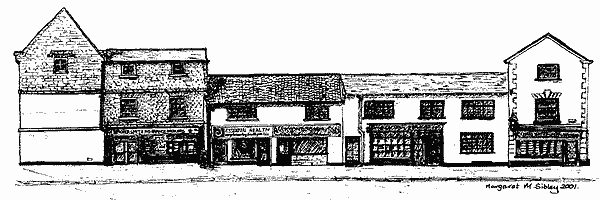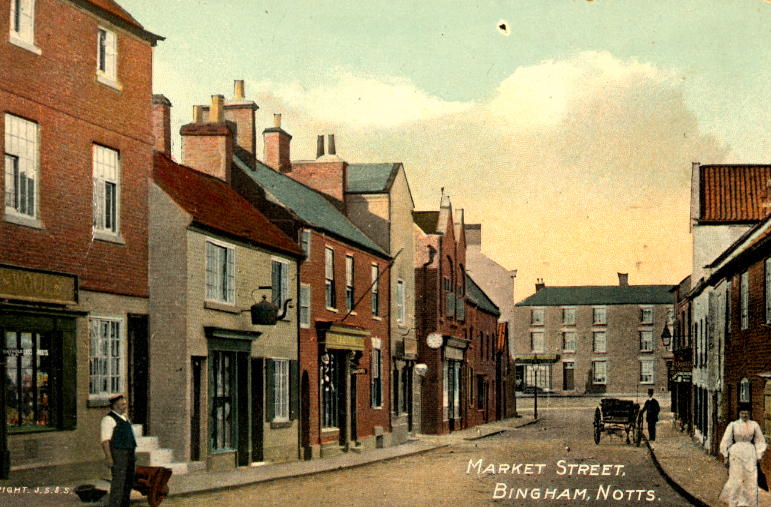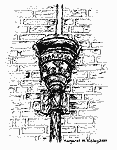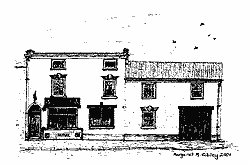![]()
Market Street, Union and Needham Streets

Market Street Facade, south-west

Market Street is mostly early to mid 19C, with some 18C. The stuccoed Georgian town house on the corner of Union Street dates from about 1820. In the early 1900s it was home and shop to a watchmaker, and latterly a shoemaker, then a saddlers. The south west side was built between 1807 and 1810 by a consortium of builders and investors including Richard Doncaster (bricklayer and possibly father of John), Val Buxton (a plumber), John Strong (postmaster), Henry Crooke (licensee of the Blue Bell) and George Baxter (grocer). The imposing edifice on the other corner of Union Street dates from the early 1900s when it replaced the much older premises of Hardstaff and Brown, grocers. James Hardstaff had been a grocer in Market Street in 1829 and grocers have occupied the site ever since. The new building was clearly built to impress, but in the event they ceased trading in 1933 when the Heafford family purchased the business. One branch of the family lived at 8 Newgate Street. The present owners took over in 1968. Part of the hardware store was originally a stable and store, dating from mid 19C with some fine brickwork. The remains of a medieval murder were discovered during building works here in 1982. The former Hopkinson's butchers shop was built in 1840; it closed in 1996. Hopkinson's ran cattle on Crow Close as generations of butchers have done on similar land over the years. Mr Downing preceded them. His slaughterhouse was in Chapel Yard behind his house at the corner of Moor Lane and Newgate Street, now all demolished.
Both sides of Market Street developed in similar ways, with the Chinese restaurant being only the latest piece of infill built in 1989. The architect was Frank Elkinton of Woodborough. The narrow three-storey building, currently an electrical wares showroom, is actually the gable end of a late 18C three-storey farmhouse that now overlooks the restaurant car park. A restored contemporary framework knitting workshop with the typical long window flanks the farmhouse to the east. The shop in the gable end had been a pharmacy with off licence for most of the century, latterly in the ownership of Mr E Dixon. Dixon had extended his shop into the cottages next door. The two boot scrapers indicate that the doorways are still in their original positions. The cottages may have been tied to the farmhouse. The first floor left hand window frames without the extended horns of the others look original and certainly date from the first part of the 19C. The white gates gave access through the original enclosed farmyard to Mr Dixon’s night bell, which provision was gratefully used by many residents up to his retirement in 1989.

North West Facade, Market Street
![]()
 Brompton House |
Needham StreetFrom the early 19C until the clearances of the 1950s Needham and Union streets were lined by poor quality houses and must have been quite unpleasant in their day. The Needham family owned a two-acre close bounded on the South East by Market Street (then described as Town Street) and Long Acre in the late 17C and for all of the 18C. It was eventually the site for the 1807-1810 development of SW Market Street, Union Street and Needham Street. Brompton House in Needham Street is a large Georgian building and has seen life as a milliners and candle makers. Candle wax was found in the cellars during restoration as part of the Bingham Townscape Scheme- see the award plaque over the doorway. Some rooms have the original fireplaces. Built in several phases the earliest seems to have been 1831, evidenced by the original drainpipe and dated brick (GB 1831) at the rear. The right hand doorway is not original either, but was a Victorian alteration. It was originally centrally located and would have been within easy reach of the boot scraper which is original! Brompton House may have been occupied by John Mabbott, lace agent who is listed in the 1841 census as aged 60 with nine children. A large family house would have been quite appropriate! The initials GB are probably for George Berry, draper who is mentioned in directories from 1832 to 1865 and in the 1841 census comes immediately before the entry for John Mabbott. Perhaps these were two separate residences. The smaller would probably have been adequate for the unmarried Berry! |
![]()
|
Union Street was named for the original workhouse built in 1818 where the wool shop (number 3) now is and the forerunner of Stanhope House built in 1837. That first workhouse may well have become the large lodging house run in 1861 by Thomas Dickman, a tailor and lodging house keeper. Could his tailor's business have been next door at number 1? His sixteen lodgers included several labourers, a fishmonger, a hatter and a skinner! In 1841 Miss Elizabeth Wright ran a boarding school for girls (seven pupils on census night!) in Union Street. The Methodist Church and schoolroom date from 1818 and have been much altered during the 20C. The original cottages, which still existed in 1950, have been replaced by infill since 1960, expanded access to the rears of Market Street shops and a small car park (once Escort Yard). The latest 21st century infill of Linley Court (see Long Acre) continues the process! Butlers |
 |
Union Street is blessed with Butlers, the former butchers', at No7. Lately restored (another Town Scheme award winner), this boasts a slaughterhouse building in the rear yard that was still in use in 1951; the cattle were driven to their fate through the gateway. The buildings were part of the 1807 development described in the paragraphs above on Market Street. Samuel Pilgrim is recorded as a tenant of that development. It was a butchers' from the early 1900s (Walkers until 1935 when it became Butlers) until 1989 and before that a bakers. The western part was two very small cottages until the late 19C. Doors have been removed over the years to accommodate growing trade and residential requirements. These cottages may have been there before the ‘new’ development as part of the Needham’s property as there used to be a path through a gateway in the wall from the yard of number 7 through to what is now the post office yard, suggesting regular access was needed in days past.
Samuel Pilgrim is recorded in 1822 as a baker and flour dealer of Union Street. At the back of the oldest part of the property there is a wooden sack chute that would have been used for moving flour. Samuel Pilgrim appears in directories until 1853. This directory also has Henry Huskinson as a baker in Union Street and it is 'known' Huskinsons were at 'Butlers'. A George Huskinson had been a baker in Cherry Street in 1848 - does this imply a family alliance with the Pilgrims? Descendants of Huskinson are recorded as bakers in Union Street directories until 1889. During the 1890's Joseph Walker seems to have moved his butchers business here from Long Acre.
So it would seem the property has been owned by only four families through about 200 years.
